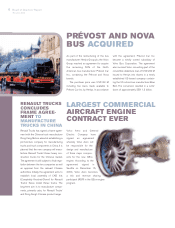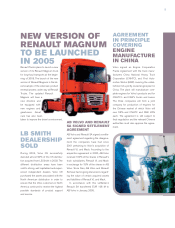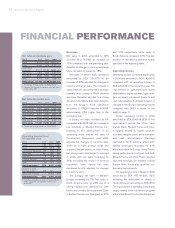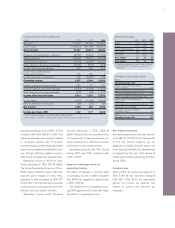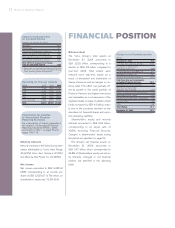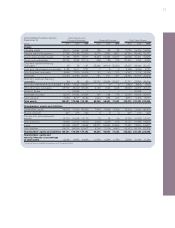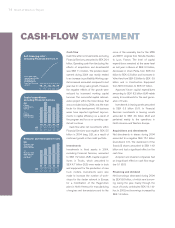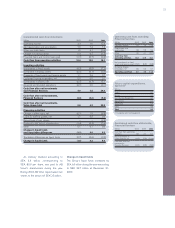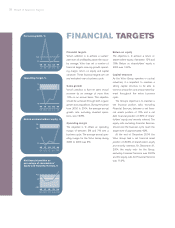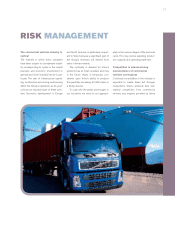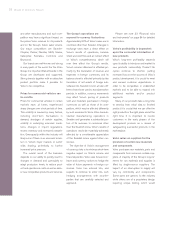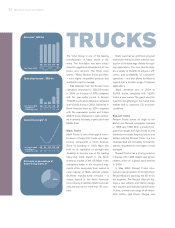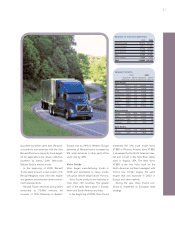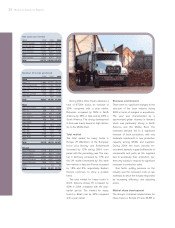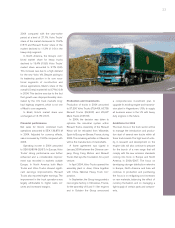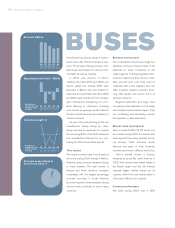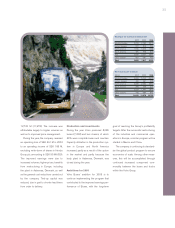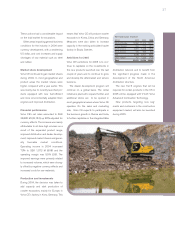Volvo 2004 Annual Report Download - page 20
Download and view the complete annual report
Please find page 20 of the 2004 Volvo annual report below. You can navigate through the pages in the report by either clicking on the pages listed below, or by using the keyword search tool below to find specific information within the annual report.
18 Board of Directors’ Report
and other manufacturers, and such com-
petition may have a significant impact on
the prices Volvo receives for its products
and on the Group’s future sales volume.
Our major competitors are Daimler-
Chrysler, Paccar, Navistar, MAN, Scania,
Caterpillar, Komatsu, Cummins and
Brunswick.
Our brands are well-known and strong
in many parts of the world. For the Volvo
Group, it is important that all brands in the
Group are developed and supported.
Strong brands together with an attractive
product portfolio make it possible for
Volvo to be competitive.
Prices for commercial vehicles can
be volatile
Prices for commercial vehicles in certain
markets have, at times, experienced
sharp changes over short periods of time.
This volatility is caused by many factors,
including short-term fluctuations in
demand, shortages of certain supplies,
volatility in underlying economic condi-
tions, changes in import regulations,
excess inventory and increased competi-
tion. Overcapacity within the industry will
likely occur if there is an economic down-
turn in Volvo’s major markets or world-
wide, leading, potentially, to further
increased price pressure.
The overall result of the business
depends on our ability to quickly react to
changes in demand and particularly to
adapt production levels, to reduce prod-
uct and operational costs as well as deliv-
er new competitive products and services.
The Group’s operations are
exposed to currency fluctuations
Approximately 90% of Volvo’s sales are in
countries other than Sweden. Changes in
exchange rates have a direct effect on
Volvo’s results of operations, balance
sheet and cash flow and an indirect effect
on Volvo’s competitiveness, which will
over time affect the Group’s results.
Volvo’s income statement is affected pri-
marily by the translation of revenue and
expenses in foreign currencies, and its
balance sheet is affected primarily by the
translation of net assets of foreign sub-
sidiaries into Swedish kronor at rates dif-
ferent from those used to translate earlier
periods. In addition, currency movements
may affect Volvo’s pricing of products
sold and materials purchased in foreign
currencies as well as those of its com-
petitors, which may be affected differently
by such movements. Since Volvo has sub-
stantial manufacturing operations in
Sweden and generates a substantial por-
tion of its revenues in currencies other
than the Swedish krona, Volvo’s results of
operations would be materially adversely
affected by a considerable appreciation
of the Swedish krona against other cur-
rencies.
The objective of Volvo’s management
of currency risks is to minimize short-term
negative impact on Volvo’s income and
financial position. Volvo uses forward con-
tracts and currency options to hedge the
value of future payments in foreign cur-
rencies. Volvo has entered into, and
expects to continue to enter into, such
hedging arrangements with counter-
parties that are carefully selected and
approved.
Please see note 33 “Financial risks
and Instruments” on page 84 for detailed
information.
Volvo’s profitability is dependent
upon the successful introduction of
new products
Volvo’s long-term profitability depends
upon its ability to introduce and market its
new products successfully. Product life
cycles continue to shorten, putting
increased focus on the success of Volvo’s
product development. It is crucial to meet
and exceed customer expectations in
order to be competitive in established
markets and to be able to expand into
additional markets and/or product
segments.
Many of our products take a long time
to develop from initial idea to finished
product. It is crucial that we can offer the
right products in the right place and at the
right time. It is important to involve
customers in the early phases of the
development process as a means of
safeguarding successful products in the
marketplace.
Volvo relies on suppliers for the
provision of certain raw materials
and components
Volvo purchases raw materials, parts and
components from numerous outside sup-
pliers. A majority of the Group’s require-
ments for raw materials and supplies is
filled by single-source suppliers. The
impact of an interruption in supply will
vary by commodity and components.
Some parts are generic to the industry
while others are of a proprietary design
requiring unique tooling, which would


